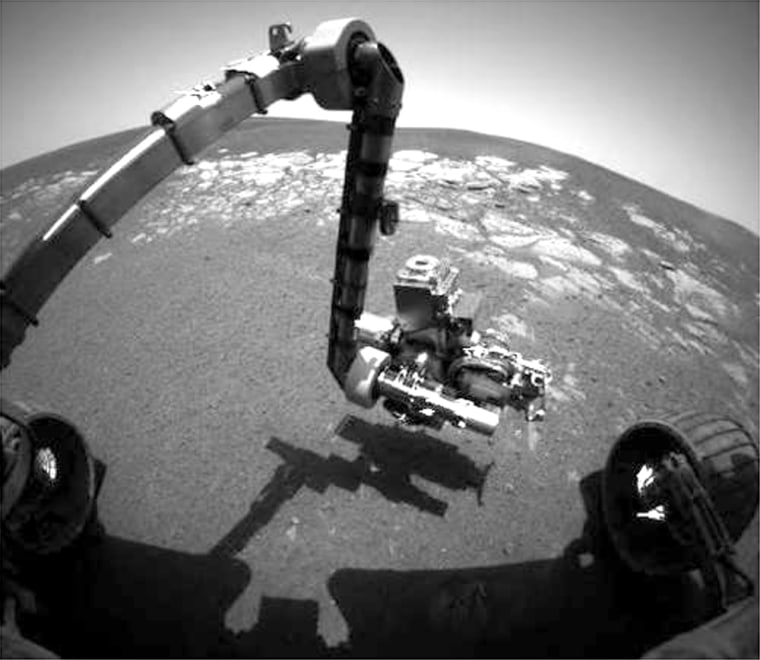NASA’s Mars rover Opportunity has successfully moved its robotic arm for the first time in almost two weeks, prompting a series of discussions on the future use of the automaton’s appendage, the mission’s manager said Thursday.
Jim Erickson, project manager NASA’s Mars Exploration Rover (MER) mission, said engineers are going over the different risks associated with a finicky shoulder motor used to deploy Opportunity’s instrument-laden robotic arm.
The motor stalled on Nov. 25, fixing the arm in its stowed configuration — tucked close to Opportunity’s undercarriage for drives — and preventing study of a nearby rock outcrop at the rover’s Meridiani Planum landing site.
But rover handlers managed to move the arm slightly in a Thursday test, Erickson told SPACE.com after a presentation here at NASA’s Risk Management 2005 conference.
The glitch, a sign of Opportunity’s age as it completes its first Martian year (about 687 Earth days) of exploration on Dec. 12, has prompted some talks over the risk of driving the rover with its arm partially deployed — elbow out — to ensure continued science operations, though more study is required before a decision is made, rover managers said.
“Would we get effective science at this position, what is the risk of doing it, what is the risk of not doing it,” Erickson said of the questions he hopes to discuss.
One potential trade-off could affect Opportunity’s ability to take stereo images of science targets with its arm-mounted Microscopic Imager camera, rover managers said. Since there is only one imager on the rover arm, Opportunity builds stereo views of targets by shifting the camera slightly to the side. With the shoulder joint locked in a partially deployed position, rover handlers would have to shift Opportunity itself to generate the images, Erickson said.
Prior to the January 2003 launch of Opportunity and its robotic twin Spirit, engineers did perform some test drives with the rover arm in a partially deployed position, Erickson said. But before any decision is made for Opportunity, rover planners will revisit the results of those tests, and likely conduct new maneuvers, he added.
In order to move Opportunity’s stalled arm, engineers fed a higher voltage through the coils of wire inside the shoulder motor to move it back and forth, said John Callas, deputy manager of the rover mission, in a telephone interview.
“The motion was very small, but it was perceptible,” Callas said, adding that more tests were set for Thursday evening.
A break in one of the wire coils inside the affected shoulder joint motor appears to be the source of the glitch, engineers said. Nine coils, or windings, sit inside the motor, Callas added.
Meanwhile, Spirit continues to function well at its Gusev Crater landing site, Callas said.
Spirit, which launched earlier than Opportunity in 2003, celebrated its first Martian birthday last month
